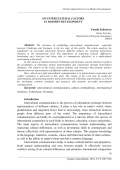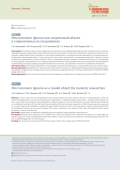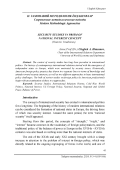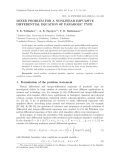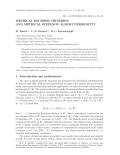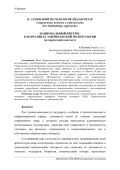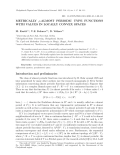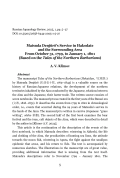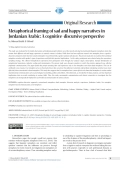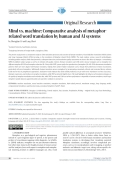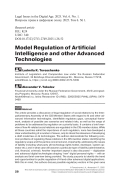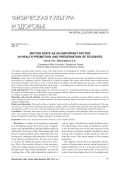Ayniqsa, O’zbekiston va Germaniya o’rtasida madaniyatlararo aloqa o’rnatishning dolzarbligi ushbu maqolaning asosiy mavzusi hisoblanadi. Maqolada xalqaro miqyosda uyg’un munosabatlarni ta’minlash uchun turli madaniyatlar o’rtasidagi muvaffaqiyatli o’zaro munosabatlarning ahamiyati tahlil qilingan. Madaniy farqlarni hurmat qilish, dunyoqarashini kengaytirish va ko’p madaniyatli muhitda samarali muloqot qilishning ahamiyati muhokama qilinadi.
O’zbekiston va Germaniya munosabatlari sharoitida madaniyatlararo muloqotlar orqali o’zaro tushunish va hamkorlikni takomillashtirish imkoniyatlariga alohida e’tibor qaratilmoqda. Maqola mualliflari turli madaniyatlar va mamlakatlar vakillari o’rtasidagi ijobiy munosabatlarni rivojlantirishga yordam beradigan usul va strategiyalarni tahlil qiladilar. Muvaffaqiyatli madaniyatlararo muloqot xalqaro hamkorlik va nizolarni hal qilish uchun qanchalik muhim ekanligi ushbu tadqiqotda muhokama qilinadi. Ish natijalari
O’zbekiston va Germaniya o’rtasidagi ijobiy munosabatlarni tushunish va rivojlantirish, shuningdek, muvaffaqiyatli madaniyatlararo aloqalarni rivojlantirishga yordam beradigan umumiy standartlar va amaliyotlarni ishlab chiqish uchun foydali bo’lishi mumkin.
В последние годы в список модельных организмов внесен свободноживущий плоский червь Macrostomum lignano, нашедший широкое применение в ряде областей научных изысканий. Его ключевая особенность, высокий потенциал к регенерации, предоставляет ему устойчивость к токсичным соединениям и онкогенам, высокую адаптивность к резким изменениям факторов окружающей среды, а также длительный срок жизни, граничащий с условным бессмертием. С другой стороны, особенности хромосомного состава генома M. lignano, выраженные в ряде геномных нестабильностей, вкупе с регенерацией, не переходящей в опухолевый генез, открывает широкие возможности для фундаментальных исследований противораковых терапий. Обзор посвящен разбору направлений биологических наук, где применяется или мог бы применяться M. lignano.
Xavfsizlik tadqiqotlari konteksti uzoq vaqtdan beri xalqaro siyosatda keng tarqalgan. Zamonaviy xalqaro munosabatlar tarixi Evropada xavfsizlik masalalari bilan bog’liq bo’lgan mustaqil davlatlarning paydo bo’lishi bilan boshlandi. Tarixiy jihatdan Amerika tashqi siyosati amaliyoti xavfsizlik manfaatlariga nisbatan bilim va munosabat nuqtai nazaridan ikkita alohida yo’nalishni, shuningdek, xalqaro siyosatning asosiy muammolariga ikki xil yondashuvni jalb qildi. Amerikalik mutaxassislar tomonidan tashqi siyosat bo’yicha jiddiy tadqiqotlarning asosiy qismi ushbu ikki yondashuvni o’rganishdan boshlanadi.
In this paper, we consider a nonlinear impulsive parabolic type partial differential equation with nonlinear impulsive conditions. Dirichlet type boundary value conditions with respect to spatial variable is used, and eigenvalues and eigenfunctions of the spectral problem are founded. The Fourier method of the separation of variables is applied. A countable system of nonlinear functional equations is obtained with respect to the Fourier coefficients of the unknown function. A theorem on a unique solvability of the countable system of nonlinear functional equations is proved by the method of successive approximations. A criteria of uniqueness and existence of a solution for the nonlinear impulsive mixed problem is obtained. A solution of the mixed problem is derived in the form of the Fourier series. The absolute and uniform convergence of the Fourier series is proved.
We analyze the metrical Bochner criterion and a new class of multi-dimensional metrically Stepanov almost periodic type functions. We clarify the main structural properties for the introduced classes of functions, including the Bochner criterion, and provide certain applications to Doss-p-almost periodic functions. We also study the extensions of almost periodic sequences and briefly explain how we can apply the established theoretical results to the abstract Volterra integro-differential equation
Xalqaro munosabatlarni uzoq vaqt davomida o’rganish davomida “milliy manfaatlar” g’oyasi siyosatning asosiy printsipi bo’lib qolmoqda. Zamonaviy xalqaro munosabatlar o’ttiz yillik urush va Vestfaliya tinchligining imzolanishi davridan kelib chiqqan bo’lib, Raison d’etat yoki “davlat aql-zakovati”dan kelib chiqqan Evropaning suveren davlatlari fenomenini xalqaro sahnaga olib chiqdi. Aynan o’sha paytda “milliy manfaatlar”iborasi paydo bo’ldi. Tarixiy jihatdan, Amerika tashqi siyosat amaliyoti milliy manfaatlarga bo’lgan bilim va munosabat nuqtai nazaridan ikkita alohida yo’nalishni, shuningdek, xalqaro siyosatning asosiy muammolariga ikki xil yondashuvni qo’llagan. Amerikalik mutaxassislar tomonidan olib borilgan tashqi siyosat bo’yicha jiddiy tadqiqotlarning aksariyati taklif qilingan tadqiqotda tahlil qilingan ushbu ikkita yondashuvni ko’rib chiqishdan boshlanadi.
We consider several new classes of metrically ρ-almost periodic type functions F: I ×X →Y, where ∅ = I ⊆ Rn, X is an arbitrary non-empty set and Y is a sequentially completelocally convex space. We briefly explain how the introduced notion can be useful in the study of qualitative analysis of solutions for some classes of the abstract Volterra integro-differential inclusions in locally convex spaces.
The manuscript Tales of the Northern Barbarians (Hokuidan, 「北夷談」) by Matsuda Denjūrō (松田伝十郎, 1769-1843) is a valuable source on the history of Russian-Japanese relations, the development of the northern territories inhabited by the Ainu conducted by the Japanese, relations between the Ainu and the Japanese, their barter trade. The written source consists of seven notebooks. The manuscript was created in the first years of the Bunsei era (文政, 1818-1831). It describes the events from 1799 to 1822 in chronological order, i. e., events that occurred during the 24 years of Matsuda’s service in the lands of the Ainu. The manuscript is written in cursive (Japanese: “grass writing”, sōsho 草書). The second half of the first book examines the bear festival and the inau, cult objects of the Ainu, which were described in detail by the author in [Klimov A. V. 2024].
This article is the continuation of the description of the events of the first notebook, in which Matsuda describes: wintering in Akkeshi, the life and clothing of the Ainu, the peculiarities of hunting sea lions, the attitude towards the moon fish, wintering in Aputa, the fight against the smallpox epidemic that arose, and his return to Edo. The text is accompanied by numerous sketches. The illustrations in the manuscript are of great value, providing additional information that is missing from the text itself. Matsuda’s descriptions refer to November 1799 - January 1801. The Hokuidan manuscript has not yet been translated into any of the European languages other than Russian. The author of this article provides translations of fragments of the written source in the chapters of published collective monographs [Klimov A. V. 2020; Klimov A. V. 2021; Klimov A. V. 2022]. The translation was carried out from the published text of the Japanese manuscript in the ten-volume series of written monuments entitled Collection of Historical Materials About the Life of the Common People of Japan (Nihon shomin seikatsu shiryō shū sei 日本庶民生活史料集成), in the fourth volume [Matsuda 1969]. In addition to this series, the Tales were published in Old Japanese in the fifth volume of a six-volume series of written monuments called Library: Northern Gate (Hokumon sō sho 北門叢書), published in 1972.
This study was motivated by the initial observations of Jordanian people’s distinct use of live (novel) and dead (conventional) linguistic metaphors when they narrate their different sad and happy experiences in natural contexts in Jordan. While there has been sufficient research into metaphor from a cognitivediscursive perspective, there has been a lack of metaphor research that links cognitive analysis with practice. The present study aims to examine if live and dead metaphors correlate with speaker’s types of experiences and find their practical implications. In this study, participants were selected using the convenience sampling strategy. The collected metaphorical expressions from participants went through four analysis stages: transcription, manual identification of metaphorical expressions, inductive coding and interpretation. The present study uses discourse analysis to enrich the practice approach (e. g., effective (in)formal communication). This paper found that people narrating their sad experiences rely on live metaphors more than dead metaphors. This can be attributed to two reasons. Live metaphors serve as rhetorical devices that can attract the addressee’s attention and facilitate articulating sensitive issues more effectively than conventional or dead metaphors. This study thus suggests that live metaphors have a more effective role than dead metaphors in various modes of professional communication such as psychological counselling, politics and debates. This distinction, as revealed by the data analysis, can bear important implications that are worth considering in various fields. Thus, this study recommends communication and rhetoric researchers to investigate how live metaphors can strategically be employed in such modes of communication in various cultures.
The present study presents a comparative analysis of the translation processes and outcomes of human translators, Neural Machine Translation (NMT) systems and Large Language Models (LLMs) focusing on the translation of Metaphor-related Words (MRW). The study employs various research methodologies, including product analysis, think-aloud protocols, subsequent interviews, and translation quality assessments to uncover the choice of strategies in translating MRWs by different subject groups as well as its relation with quality criterion. Human translators and LLMs tend to favour strategies such as metaphor into different metaphor (M-M2) and metaphor reduction (M→Non), while NMT systems prefer the reproduction of metaphors (M→M). LLMs demonstrate translation patterns which are more aligned with human translators, helping them achieve higher evaluation scores, though their performance remains inconsistent, particularly with novel metaphors. Additionally, human translators process metaphors by incorporating conceptual, cultural, and contextual factors, whereas LLMs tend to rely on paraphrastic approaches. Evaluation results indicate that LLMs exhibit proficiency on par with novice translators in terms of accuracy, idiomatic expression, and vividness in metaphor translation, while NMT systems fall slightly short. The study highlights the influence of translation strategies on the quality of metaphor translation and concludes that, while NMT systems and LLMs can achieve performance comparable to human translators, much larger metaphor-specific datasets supported studies are expected to validate its consistency.
The article provides a discussion of legal regulation of social relations by the Interparliamentary Assembly of the CIS Member States with regard to AI and other advanced information technologies, identifiable regulatory gaps, conceptual framework, analysis of possible use scenarios and related risks, as well as the range of problems to be addressed by regulation on a priority basis. It contains a brief overview of how AI-related social relations are regulated in the CIS member states. While all these countries admit the importance of such regulation, none has developed a clear understanding of a number of issues, only to stress the relevance of developing a draft model law on AI technologies. The authors demonstrate the following common problems of regulating these relations in the CIS member states: identifying the regulatory scope and the parties concerned and, importantly, addressing the issues of liability including what party (AI technology rights holder, developer, system operator etc.) and in what case will assume a particular type of liability (administrative, civil, financial, criminal). Another important aspect is also discussed — digitization and advanced digital technologies shaping “new” digital personal rights — with an analysis and brief overview being provided. The study purports to identify the trend and opportunities for public regulation of AI and other advanced digital applications. With this in mind, the authors discuss possible regulatory vectors in the given area in light of the risks related to operational specifics of digital technologies, and identify groups of social relations to be adequately addressed by legal regulation. With digitization covering an ever wider range of social relations, the problems to be addressed by law include the protection of personal rights as well as prevention of nondiscrimination of individuals and economic agents. The article employs a number of scientific methods of inquiry, general and special research methods including the formal law method. The general research methods include systemic, dialectic, structural systemic, analytical/synthetic, inductive and deductive methods, abstraction, simulation. The article concludes that, while the CIS countries are at different regulatory stages in the discussed area, there is no comprehensive regulation, with only individual provisions and regulations in place to govern specific aspects of AI use. A model law, once developed, will allow to lay the ground for comprehensive regulation of the discussed relations by the national legislation.
The authors consider motor activity as one of the main factors in maintaining the health of students. The analysis of the student’s daily living activity with su cient and de cient motor activity is carried out. Many programs have been studied that contribute to improving the motion state of students. Revelance. Today, due to the “digitalization” and the increase in online goods and services, the problem of health impairment related to a sedentary lifestyle. Especially it’s actual for students who devote most of their time to study and put their physical health on the back or even on a back burner. In addition, the information ow increases, which students have to process that is educational literature, some classes - everything goes to online mode. It leads to an even greater deterioration and acute condition of the student’s health. Goals and objectives. The working purpose is to provide an overview of scienti c publications on this topic, to identify the sources of deterioration of youth health, to get acquainted with the in uence of motor mode on the student’s life and to conduct an analysis of various programs in this eld. Materials and research methods. Scienti c sources published in the scienti c electronic library elibrary (website https://elibrary. ru) were used as research materials. Research methods: study of scienti c literary sources, review of scienti c publications. Results and discussion. The positive e ect of students’ motor activity on health has been proved scienti cally. The state and society are interested in educating and creating a healthy nation. Scientists and specialists develop many methods and programs on this issue every year, but despite all made e orts, the trend of deteriorating health still conserves. Conclision. In literature and science, there is a su cient number of programs and techniques aimed at increasing students’ motor activity. Society needs not only to develop this problem on a threoretical level, but also to introduce the proposed solutions in the eld of higher education of students actively.
